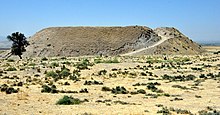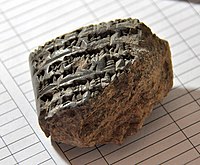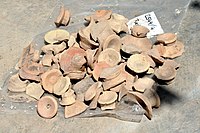Bakr Awa
Bakr Awa is a tell, or archaeological settlement mound, in Iraq. It is located near Halabja in the Shahrizor Plain in Iraqi Kurdistan. The site is 40 metres (130 ft) high and consists of a central settlement mound surrounded by a lower city measuring 800 by 600 metres (2,600 ft × 2,000 ft).[1]
The site was first investigated in 1927 by Ephraim Speiser as part of a more general study of the area. Subsequent excavations took place in 1961 and 1961 by archaeologists from the Iraqi Directorate-General of Antiquities. In 2009 the site was surveyed. New excavations were started in 2010, with subsequent seasons taking place in 2011, 2013, and 2014. The survey and the 2010-2014 excavations were undertaken by a team from the University of Heidelberg.[1]
The oldest excavated layers date to the third millennium BC and are contemporary with the Jemdet Nasr and Early Dynastic periods. A small temple dates to the Akkadian period. Large houses and tombs were recovered from the second millennium BC occupation layers. Occupation continued into the Late Bronze Age. Material culture from these layers showed links with the Hurrian and Kassite cultures. Iron Age occupation at Bakr Awa dates to the Neo-Assyrian period and the Achaemenid Empire. A Sassanian occupation at Bakr Awa is likely, but hasn't been proven beyond doubt. Islamic period occupation ranges from the Abbasid period into the Ottoman period. The site continues to be occupied today.[1]
Gallery
 The ancient mound of Bakr Awa
The ancient mound of Bakr Awa September 18, 2014. Excavations at Bakr Awa
September 18, 2014. Excavations at Bakr Awa A fragment of a clay tablet with a cuneiform inscription, unearthed in September 2014 at Bakr Awa
A fragment of a clay tablet with a cuneiform inscription, unearthed in September 2014 at Bakr Awa A 1st-millennium BCE, probably Neo-Assyrian, grave at Bakr Awa
A 1st-millennium BCE, probably Neo-Assyrian, grave at Bakr Awa Fragments of pottery unearthed at Bakr Awa
Fragments of pottery unearthed at Bakr Awa
References
- "Bakr Awa". www.assur.de. Retrieved 2017-11-10.